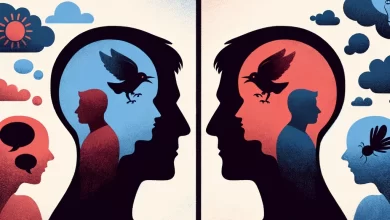Understanding Anxiety Disorder: Symptoms & Help
Do you feel a sense of unease and uncertainty that interferes with your everyday activities? Are you constantly overwhelmed by fear and worry? You’re not alone. Anxiety disorders affect nearly 1 in 5 American adults each year, making it one of the most common mental health conditions in the United States.
Anxiety disorders can manifest in various forms, such as social anxiety disorder, generalized anxiety disorder, and panic disorder. But what exactly is anxiety, and how does it affect our bodies?
In this article, we delve into the world of anxiety disorders, exploring their symptoms, treatment options, and coping strategies. Whether you’re seeking information for yourself or a loved one, understanding anxiety disorder is the first step toward finding effective help.
Key Takeaways:
- Anxiety disorders affect nearly 1 in 5 American adults each year.
- Understanding anxiety and its impact on the body is crucial in managing anxiety disorders.
- Generalized anxiety disorder, panic disorder, and social anxiety disorder are common types of anxiety disorders.
- Diagnosis and treatment options for anxiety disorders include therapy, medication, and support from healthcare professionals.
- Self-help techniques, coping strategies, and support groups can enhance anxiety management and overall well-being.
What is Anxiety?
Anxiety is our body’s natural response to stress and potential danger. It is a normal and necessary emotion that helps us survive by triggering a fight-or-flight response. When we encounter a threat or perceive a threat, our body releases stress hormones such as cortisol and adrenaline, which increase our heart rate, heighten our senses, and prepare us to defend ourselves. This response is essential for our survival in dangerous situations.
However, anxiety can become excessive and interfere with our daily lives, leading to anxiety disorders. These disorders involve individuals experiencing persistent feelings of anxiety, even in the absence of an immediate threat. They may constantly feel on edge, have difficulty controlling their anxious thoughts, or experience physical symptoms such as muscle tension and restlessness.
Understanding anxiety is crucial in managing this condition. By recognizing the body’s natural reaction to stress and threat, individuals can develop strategies to regulate their anxiety levels and seek appropriate treatment if necessary. Ignoring or dismissing anxiety can worsen symptoms and lead to long-term distress.
“Anxiety is a normal and necessary emotion that helps us survive by triggering a fight-or-flight response.”
By acknowledging that anxiety serves a purpose in our survival, we can view it as a natural response rather than a sign of weakness or incompetence. This perspective can help reduce the stigma surrounding anxiety disorders and encourage individuals to seek the support they need.
The Relationship Between Stress and Anxiety
Stress is often a triggering factor for anxiety. When faced with a stressful situation, such as a deadline or a challenging task, our body’s stress response is activated. This response is similar to the fight-or-flight response triggered by anxiety. However, while anxiety is a response to a potential threat, stress is a response to a specific stressor or demand.
Stress can become overwhelming, leading to increased levels of anxiety. When we experience chronic stress, our body’s stress response is constantly activated, keeping us in a heightened state of anxiety. This chronic anxiety can have detrimental effects on our mental and physical well-being, contributing to the development of anxiety disorders if left unaddressed.
Anxiety as a Disruption to Daily Life
While anxiety is a normal emotional experience, it becomes problematic when it interferes with our ability to function effectively and engage in daily activities. Individuals with anxiety disorders may find it challenging to concentrate, make decisions, or maintain healthy relationships due to their heightened state of anxiety.
“Anxiety disorders can cause significant distress and impairment in various areas of life, including work, school, and relationships.”
It’s important to note that anxiety disorders manifest in different ways and can affect individuals differently. Some may experience frequent panic attacks, while others may constantly worry about specific triggers or experience social anxiety in social situations.
A Holistic Approach to Anxiety Management
Anxiety disorders require a holistic approach to management and treatment. This includes addressing both the psychological and physiological aspects of anxiety. Therapy, such as cognitive-behavioral therapy (CBT), can help individuals identify and modify negative thought patterns and develop healthier coping mechanisms. Medications may also be prescribed in some cases to alleviate symptoms and restore a balance in brain chemistry.
In addition to professional treatment, individuals can also incorporate self-help strategies into their daily routines to manage anxiety. These strategies may include mindfulness techniques, relaxation exercises, regular physical exercise, and maintaining a healthy lifestyle.
| Self-Help Techniques for Anxiety Management |
|---|
| Mindfulness and meditation exercises |
| Deep breathing techniques |
| Progressive muscle relaxation |
| Regular exercise and physical activity |
| Avoiding excessive caffeine and alcohol consumption |
| Getting adequate sleep |
| Engaging in hobbies and activities that bring joy and relaxation |
“A holistic approach to anxiety management involves addressing both the psychological and physiological aspects of anxiety.”
It’s important to note that everyone’s experience with anxiety is unique, and what works for one person may not work for another. Finding the right combination of strategies and treatments may involve some trial and error. Open communication with healthcare professionals and seeking support from loved ones can help individuals navigate their anxiety journey.
Remember, anxiety is a common human experience, and seeking help is a sign of strength and self-care. By understanding anxiety and taking proactive steps to manage it, individuals can regain control of their lives and experience an improved overall well-being.
Generalized Anxiety Disorder (GAD)
Generalized Anxiety Disorder (GAD) is a common mental health condition characterized by constant anxiety and excessive worry about daily activities or events. People with GAD often feel like they have little control over their worry, leading to persistent and intrusive thoughts that interfere with their daily lives.
GAD can cause individuals to experience a range of symptoms that affect both their physical and mental well-being. These symptoms may include:
- Constant Anxiety: Individuals with GAD often experience a sense of persistent, low-level anxiety that is present most of the time.
- Excessive Worry: People with GAD may worry excessively and uncontrollably about various aspects of their lives, such as money, health, family, work, or other daily occurrences.
- Difficulty Concentrating: GAD can make it challenging to focus, making it difficult to complete tasks or engage in daily activities.
- Restlessness: Many individuals with GAD may experience a constant sense of restlessness or feeling on edge.
- Fatigue: GAD can cause persistent fatigue or exhaustion, even when individuals haven’t engaged in physically demanding activities.
- Muscle Tension: Physical symptoms such as muscle tension and aches are common in individuals with GAD.
These symptoms can significantly impact a person’s ability to function in their daily life. People with GAD may find it challenging to complete tasks, maintain relationships, or enjoy activities they once found pleasurable.
It’s essential for individuals experiencing symptoms of GAD to seek professional help and support. A healthcare professional can provide an accurate diagnosis and recommend appropriate treatment options, which may include therapy, medication, or a combination of both.
Living with generalized anxiety disorder can be challenging, but with the right support and treatment, individuals can learn to manage their symptoms and regain control over their lives.
Awareness of GAD and its impact on individuals’ lives is crucial for promoting understanding and empathy. By recognizing the signs and symptoms of GAD, we can create a more supportive and compassionate society for those living with this disorder.
Mindfulness-Based Stress Reduction (MBSR) Techniques for GAD
Mindfulness-based stress reduction techniques can be beneficial for individuals with GAD. Studies have shown that practicing mindfulness can help reduce anxiety symptoms and improve overall well-being.
Some mindfulness techniques that may be helpful for individuals with GAD include:
- Deep Breathing: Taking slow, deep breaths can help calm the mind, reduce anxiety, and promote relaxation.
- Body Scan: Body scanning involves consciously paying attention to the sensations in each part of the body, helping individuals become more aware of tension and release it.
- Meditation: Mindfulness meditation involves focusing on the present moment, letting go of worries and anxieties, and accepting thoughts and feelings without judgment.
- Progressive Muscle Relaxation: This technique involves tensing and relaxing different muscle groups to promote physical relaxation and release tension.
It’s important for individuals to practice these techniques regularly to experience their full benefits. Mindfulness practices can be integrated into daily routines and can be particularly helpful during times of increased anxiety or stress.
| GAD Symptoms | Examples |
|---|---|
| Constant Anxiety | A persistent feeling of unease and worry that lasts throughout the day. |
| Excessive Worry | Constantly fretting over various aspects of life, such as work, relationships, health, or finances. |
| Difficulty Concentrating | Struggling to focus or concentrate on tasks due to intrusive thoughts or anxiety. |
| Restlessness | Feeling constantly on edge or unable to relax. |
| Fatigue | Feeling tired and lacking energy, even without exertion. |
| Muscle Tension | Experiencing frequent muscle tension or stiffness, which may be accompanied by pain. |
Panic Disorder
Panic disorder is a type of anxiety disorder characterized by sudden and intense fear or anxiety, often accompanied by panic attacks. These panic attacks are typically unexpected and can occur out of nowhere, without any specific triggers. They can be debilitating and lead to significant distress and impairment in daily life.
Symptoms of panic attacks can vary but commonly include:
- Rapid heartbeat
- Sweating
- Trembling or shaking
- Chest pain or discomfort
- Dizziness or lightheadedness
- A sense of impending doom or loss of control
During a panic attack, individuals may also experience shortness of breath, a feeling of choking, nausea, or abdominal distress. These physical sensations can further intensify the fear and anxiety experienced during an attack.
Panic disorder often leads individuals to develop avoidance behaviors as a way to prevent future panic attacks. They may avoid certain situations or places that they associate with panic attacks, which can significantly impact their daily lives and limit their ability to engage in normal activities.
It’s important to note that panic disorder is different from general anxiety, as panic attacks are characterized by their sudden and intense nature, rather than being related to specific situations or triggers.
If you or someone you know is experiencing symptoms of panic disorder, it’s essential to seek professional help. With a proper diagnosis and treatment plan, individuals with panic disorder can learn to manage their symptoms and lead fulfilling lives.
Social Anxiety Disorder
Social anxiety disorder, also known as social phobia, is a debilitating mental health condition characterized by a persistent fear of judgment and embarrassment in social situations. It goes beyond normal shyness or nervousness, causing significant distress and interference in daily life.
People with social anxiety disorder often experience intense anxiety or fear when faced with social interactions, such as speaking in public, meeting new people, or participating in group activities. This fear stems from a deep concern about being scrutinized, negatively evaluated, or humiliated by others.
Symptoms of social anxiety disorder may include:
- Blushing or feeling flushed
- Sweating excessively
- Trembling or shaking
- Poor eye contact
- Difficulty speaking or finding words
- Rapid heartbeat
- Nausea or stomach discomfort
- Dizziness or lightheadedness
These symptoms can be overwhelming and may lead individuals to avoid social situations altogether. They may fear being negatively judged, embarrassed, or even ridiculed by others. Consequently, social anxiety disorder can impact various aspects of life, including education, careers, and relationships.
Social anxiety disorder is more common than many people realize, affecting approximately 7% of the US population. It can develop at any age, but it often starts during adolescence and may persist into adulthood if left untreated.
| Signs and Symptoms of Social Anxiety Disorder | Impact on Daily Life |
|---|---|
|
|
It is important for individuals experiencing symptoms of social anxiety disorder to seek professional help. Therapeutic interventions such as cognitive-behavioral therapy (CBT) and exposure therapy have been proven effective in managing social anxiety and improving overall well-being. Medication, such as selective serotonin reuptake inhibitors (SSRIs), may also be prescribed in some cases.
If you or someone you know is struggling with social anxiety disorder, remember that you are not alone. Support groups, therapy, and other resources are available to help individuals overcome their fear of judgment, build self-confidence, and navigate social situations with greater ease.
Separation Anxiety
Separation anxiety is a common psychological condition characterized by an excessive concern and fear of separation from someone to whom an individual is emotionally attached. While it is normal to experience some level of anxiety when separating from loved ones, separation anxiety disorder involves intense and disruptive worry or fear about separation.
Symptoms of separation anxiety can manifest in various ways, including:
- Excessive worry and fear when anticipating separation
- Reluctance or refusal to go to school or work
- Nightmares or difficulties sleeping alone
- Physical symptoms like headaches, stomachaches, or nausea
- Tantrums or clinginess
Separation anxiety can significantly impact different areas of life, including social relationships and work. Adults with separation anxiety may struggle to form and maintain healthy relationships due to their excessive fear of separation. In the workplace, separation anxiety can lead to difficulties concentrating and reduced productivity.
It is important to seek professional help if you or someone you know is experiencing symptoms of separation anxiety. Treatment options may include therapy, cognitive-behavioral techniques, and, in some cases, medication. With the right support and intervention, individuals can learn to effectively manage their separation anxiety and improve their overall well-being.
| Symptoms | Impact |
|---|---|
| Excessive worry and fear when anticipating separation | Interferes with daily activities and relationships |
| Reluctance or refusal to go to school or work | Impairs academic or occupational functioning |
| Nightmares or difficulties sleeping alone | Disrupts sleep patterns and quality of rest |
| Physical symptoms like headaches, stomachaches, or nausea | Causes physical distress and discomfort |
| Tantrums or clinginess | Affects emotional regulation and social interactions |
Phobias
Phobias are intense fears of specific objects or situations that can disrupt a person’s life. These irrational fears can cause significant distress and interfere with daily functioning. While everyone experiences fear to some extent, phobias are characterized by an excessive and persistent fear response that is out of proportion to the actual danger posed by the feared object or situation.
Common phobias include:
- Hemophobia (fear of blood): This phobia can cause individuals to avoid medical procedures or even faint at the sight of blood.
- Trypanophobia (fear of needles): People with this phobia may avoid necessary medical treatments or vaccinations due to their extreme fear of needles.
- Agoraphobia (fear of certain places or situations): Agoraphobia is a fear of open or crowded spaces and can lead individuals to avoid leaving their homes or being in situations where escape may be difficult.
Individuals with phobias often experience intense anxiety when confronted with their specific fear, leading to avoidance behaviors. This can greatly impact their daily lives, limiting their ability to engage in certain activities or go to certain places.
According to the Anxiety and Depression Association of America (ADAA), phobias are one of the most common mental disorders, affecting an estimated 8.7% of the population.
Impact of Phobias
Phobias can have a disruptive effect on an individual’s life, causing distress, anxiety, and impairment in various areas including:
- Social life: Phobias can make it challenging for individuals to participate in social activities or interact with others, leading to feelings of isolation and loneliness.
- Work and education: If a phobia is related to a specific object or situation encountered in a workplace or educational setting, individuals may avoid or struggle to perform their duties, affecting their productivity and career advancement.
- Physical health: The distress caused by phobias can take a toll on physical health, contributing to sleep disturbances, weakened immune system, and other stress-related conditions.
- Mental well-being: Living with a phobia can be emotionally draining, causing anxiety, depression, and feelings of helplessness.
It’s important for individuals with phobias to seek appropriate treatment to alleviate their symptoms and regain control over their lives.
| Phobia | Prevalence | Impact |
|---|---|---|
| Hemophobia | Approximately 3% of the population | Can lead to avoidance of medical procedures and fainting at the sight of blood |
| Trypanophobia | Estimated 10% of the population | May result in avoidance of necessary medical treatments |
| Agoraphobia | Affects about 1.7% of adults | Can severely limit individuals’ ability to leave their homes or engage in certain activities |
Diagnosis and Treatment
The diagnosis of an anxiety disorder involves a thorough evaluation by a healthcare professional. It is crucial to accurately identify the specific type of anxiety disorder to determine the most appropriate treatment plan.
Diagnosis: Healthcare professionals will conduct a comprehensive assessment, which may include a physical examination, a review of symptoms, and a discussion of medical history and family history. They will also consider any underlying medical conditions that may contribute to anxiety symptoms. Additionally, mental health assessments and standardized questionnaires may be used to evaluate the severity of anxiety symptoms and assess their impact on daily life.
Once a diagnosis is made, the healthcare professional will work closely with the individual to develop a personalized treatment plan.
Treatment: Treatment options for anxiety disorders include therapy, medication, or a combination of both.
Therapy: Cognitive-behavioral therapy (CBT) is a commonly used therapeutic approach for anxiety disorders. It focuses on identifying and challenging negative thought patterns and behaviors that contribute to anxiety. Through CBT, individuals learn coping strategies, stress management techniques, and how to gradually confront feared situations. Other types of therapy, such as exposure therapy and acceptance and commitment therapy, may also be effective depending on the specific anxiety disorder.
Medication: Medications may be prescribed to manage anxiety symptoms. Selective serotonin reuptake inhibitors (SSRIs) are commonly prescribed as they can help regulate brain neurotransmitters associated with anxiety. Other medications, such as benzodiazepines, may be prescribed on a short-term basis to alleviate severe symptoms, but they are not typically recommended for long-term use due to their potential for dependence.
Support from family, peers, and mental health professionals plays a vital role in the treatment process. Having a strong support network can provide encouragement, understanding, and guidance throughout the journey of managing anxiety.
Self-Help and Coping Strategies
While therapy and medication play crucial roles in managing anxiety disorders, individuals can also employ self-help techniques and coping strategies to alleviate symptoms and improve their overall well-being. By incorporating mindfulness techniques, relaxation exercises, regular exercise, and maintaining a healthy lifestyle, individuals can effectively reduce anxiety levels and regain control of their lives.
Mindfulness techniques are proven methods to help individuals connect with the present moment and cultivate a sense of calmness. Practices such as meditation, deep breathing exercises, and guided imagery can promote relaxation, reduce stress, and enhance self-awareness. By becoming more mindful, individuals can develop a greater understanding of their thoughts and emotions, allowing them to respond to anxiety triggers in a healthier and more adaptive manner.
Mindfulness is crucial in managing anxiety, helping individuals become more aware of their inner experiences and breaking the cycle of worry and rumination. By practicing mindfulness regularly, individuals can reduce the intensity of their anxiety symptoms and cultivate a sense of inner peace.
Engaging in relaxation exercises can also aid in alleviating anxiety. Techniques such as progressive muscle relaxation, where individuals systematically tense and relax different muscle groups, can help promote physical and mental relaxation. Other relaxation methods include listening to calming music, taking warm baths, or engaging in activities that bring joy and relaxation, such as reading or hobbies.
Relaxation exercises for anxiety relief:
- Progressive Muscle Relaxation: This exercise involves tensing and relaxing different muscle groups in the body, releasing tension and promoting relaxation.
- Deep Breathing: Deep, slow breaths can help activate the body’s relaxation response and reduce anxiety.
- Guided Imagery: Guided visualization exercises can transport individuals to peaceful, calm settings, reducing anxiety and promoting relaxation.
Regular exercise is not only beneficial for physical health but also has a positive impact on mental well-being. Engaging in physical activity releases endorphins, which are natural mood boosters and stress relievers. Whether it’s walking, jogging, dancing, or participating in sports, incorporating regular exercise into one’s routine can help reduce anxiety symptoms, improve sleep quality, and enhance overall mood.
Maintaining a healthy lifestyle is another important aspect of managing anxiety. This includes getting enough sleep, eating a balanced diet, avoiding excessive caffeine and alcohol consumption, and practicing good self-care. Taking care of one’s physical health can contribute to better mental health and overall well-being.
A healthy lifestyle forms a solid foundation for managing anxiety, providing individuals with the necessary resilience and energy to cope with stressors and reduce anxiety symptoms.
By incorporating self-help techniques and coping strategies into their daily lives, individuals with anxiety disorders can empower themselves to take an active role in managing their anxiety. These strategies, when combined with therapy and medication, can contribute to long-term anxiety relief and improved quality of life.
Support Groups and Peer Support
For individuals facing anxiety disorders, support groups and peer support can be an invaluable source of comfort and encouragement. By fostering a sense of understanding and belonging, these groups create a safe and nurturing environment where individuals can share their experiences and find solace.
Support groups allow individuals to connect with others who are going through similar challenges. Through these groups, individuals can gain a deeper understanding of their own anxiety and find comfort in knowing that they are not alone in their struggles. In support groups, participants share their experiences, exchange coping strategies, and provide emotional support to one another.
Peer support plays a fundamental role in helping individuals with anxiety disorders. Peers, who have firsthand experience with anxiety, offer insightful advice and guidance based on their own journeys. Their understanding of the unique struggles of living with anxiety creates a strong sense of empathy and validation. Support from peers can be instrumental in boosting confidence, promoting self-acceptance, and providing a sense of hope.
“Being part of a support group is like having a lifeline. It’s a space where I can openly discuss my fears and anxieties without judgment. Through shared experiences, we learn from one another and provide encouragement to keep moving forward.”
– Jane, support group participant
Support groups and peer support offer not only emotional solace but also practical tips and techniques for managing anxiety. Members often share effective strategies they have discovered through their own experiences, such as mindfulness techniques, relaxation exercises, and breathing exercises. These tools can empower individuals with anxiety disorders to develop healthier coping mechanisms and regain control over their lives.
To find support groups and peer support options near you, visit the Mental Health America website. They provide a comprehensive directory of resources where individuals can connect with others who understand their struggles and offer support.
Research and Future Developments
Ongoing research is focused on understanding the underlying causes of anxiety disorders and developing more effective treatments. Scientists and psychologists are committed to advancing our knowledge of anxiety disorders to improve diagnosis, treatment, and support for individuals.
One area of research that shows promise is brain imaging. By studying the brain structures and activities associated with anxiety disorders, researchers hope to gain valuable insights into the mechanisms behind these conditions. This information could lead to more individualized treatment approaches, tailoring interventions to each person’s unique needs and biology.
Early intervention and prevention efforts are also a key focus in research on anxiety disorders. Identifying signs of anxiety in children and adolescents and providing appropriate support and resources at an early stage can help prevent the development of more severe anxiety disorders later in life.
“Advancements in research are crucial for improving our understanding of anxiety disorders and enhancing the effectiveness of treatment options available to individuals.”
– Dr. Sarah Thompson, Lead Researcher at the Anxiety and Mental Health Institute
The ongoing research and future developments in the field of anxiety disorders offer hope for improved outcomes and quality of life for individuals experiencing these conditions. By expanding our knowledge, utilizing brain imaging techniques, and promoting individualized treatment approaches, we can make significant strides in supporting individuals with anxiety disorders.
Advancements in Anxiety Disorder Research
| Research Focus | Impact |
|---|---|
| Brain Imaging Studies | Identification of brain structures and activities associated with anxiety disorders, leading to personalized treatment approaches. |
| Early Intervention and Prevention | Identification of anxiety symptoms in children and adolescents, enabling timely support and resources to prevent the development of more severe anxiety disorders. |
Conclusion
Anxiety disorders are common and can significantly impact an individual’s daily life. The good news is that effective management is possible through proper diagnosis, treatment options, and support. Seeking help is crucial if you or someone you know is experiencing symptoms of an anxiety disorder.
With the right therapeutic interventions, including therapy and medications, individuals can effectively manage their anxiety and regain control over their lives. Alongside professional help, support from family, peers, and mental health professionals plays a crucial role in the journey towards better mental well-being.
Remember, you don’t have to face anxiety alone. There are numerous resources available to provide assistance, including support groups and peer support networks. By connecting with others who share similar experiences, you can find understanding, encouragement, and practical advice to navigate the challenges of anxiety disorders.
By taking proactive steps towards learning coping strategies, practicing mindfulness techniques, and implementing self-help techniques like relaxation exercises and exercise, individuals can enhance their anxiety management abilities and improve their overall well-being. With the right tools and support, individuals can effectively manage anxiety disorders and lead fulfilling lives.






